|
|
| |
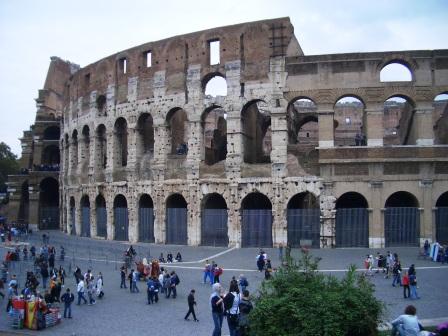
The
Roman Colosseum.
The Colosseum opened in AD 80. The largest amphitheater of
the Roman Empire, it rose 158 feet and seated 50,000 spectators.
Highlights
*
What did the Romans build? What did they
not build?
*
Roman Roads
*
Roman Aqueducts
*
Roman Concrete and Arches: Construction and Design |
|
Roman Technology
I went to the Colosseum in Rome. How can it be so big? Why did the Romans want to devote their resources to large monuments? The Etruscans built on a much smaller scale. In today's technology, engineers design
for The Small. We want to be connected, quickly, on ever-smaller devices.
The Romans didn't know how to think that way. They wanted to dominate, not share or learn from others. If they wanted to "be connected," it was to the gods, not to other humans. For them, there
was only The Big, no matter how long it took to build.
Building Big honored the gods, always a priority for the anxious Romans.
How, in their society, did they do it? The Etruscans had built temples and presumably other public buildings. Theirs were on a much smaller scale. What did the Romans bring to the table?
|
|
|
|
|
|
|
|
|
|
|
|
|
What
they built
The Romans radically changed the built environment of the
ancient world for thousands of miles in all directions.
The Romans built and built and built. Durable roads covered thousands of miles. Gigantic temples and basilicas dazzled the masses. Superior military
installations and camps frightened the opponent. Aqueducts, bridges, canals, and baths. Monuments, triumphal
arches, columns and tombs. Large-capacity theaters and
libraries. Amphitheaters and circuses. New cities, all
over the Empire.
Roman technology and the expansion of Rome
They did it with applied technology. The Romans didn't know or weren't interested in science.
Roman technology was all about power,
displayed very publicly. Along the new Roman roads flowed the principles of "Roman-ness." The
conquering Empire wanted the built environment to look "Roman."
The "Roman look" was urban, not suburban or rural. The urban
center was to be filled with towering buildings. Materials would be stone
and marble, materials of wealth and durability, not of wood and tile. The Romans were saying: "Look at us: we have all the resources and we will be here forever."
About 1000 cities were created or transformed by the Romans. These new cities were built on a rigid
grid. The city center of even the most modest showcased the civic buildings that Rome prized: temples,
the forum, theater, library, baths and other waterworks, sometimes an amphitheater,
basilicas, and the agora (market.)
Note what the
Romans did not build: schools, hospitals, or
public housing.
How could the Romans make this happen on such a large scale?
Roads and aqueducts, new building designs, and new construction
material were the keys.
|
|
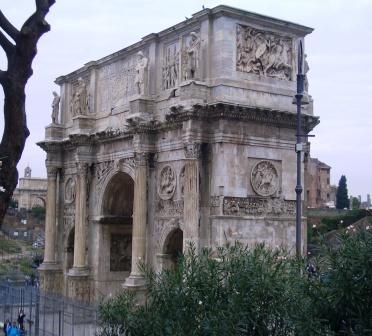
Rome.
The Arch of Constantine in the Roman Forum.
Around 50 commemorative arches were
built in Rome.
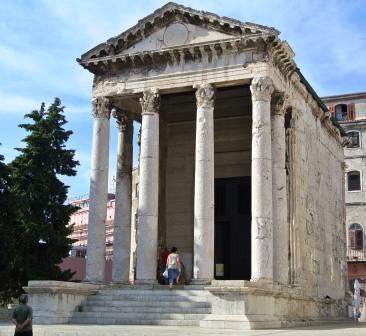
Pula, Croatia. Temple of
Augustus. Built 2 BC.
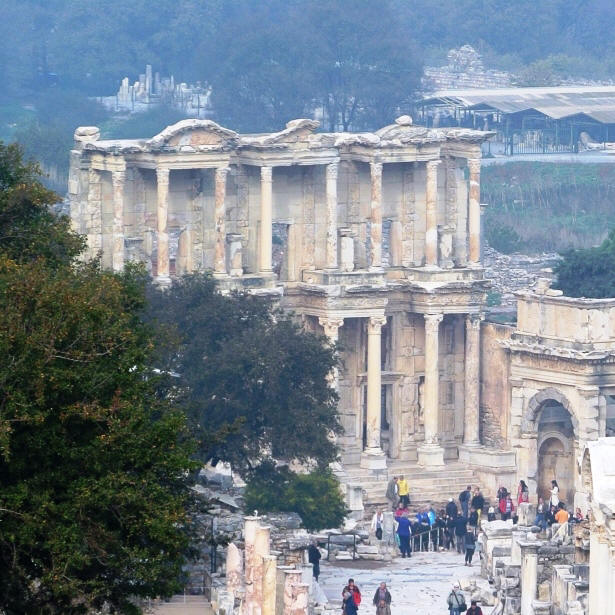
Ephesus, Turkey.
The Roman Library. Built 2nd
century AD. |
|
|
|
|
|
|
|
|
Roman Roads: Big Vision, Big Costs |
|
|
The Romans built 55,000 miles of roads.
The
Romans wanted to be everywhere. The interior of Europe and the
Near East was as attractive to them as the sea coasts.
Eventually the Roman Empire encompassed millions of people.
The Purpose of a Roman road: the Military
An
Empire of this size required a moveable military. Without good
roads to move its Army, the Empire would have been difficult to achieve.
A Roman general
needed to launch offensives and respond quickly to a land threat.
He needed infantry. The infantry needed a reliable marching
surface. The Army's logistical support, usually packed into
ox-drawn heavy carts, needed deep, metaled surfaces. The unpaved tracks and simpler roads from Etruscan and Greek
times crumbled or turned to mud in the rain.
Construction
How did the Romans build a
road? They depended largely on laborers, both slave and military, not
technology or equipment. The Romans had only a
few crude engineering devices.
Since the main purpose of the roads was to hustle foot soldiers
along, not for trade, the
roads could be built straight.
The roads might go straight up a hill
rather than contour around it. The soldiers couldn't very well
complain. To go in a straight line requires only a modest
surveying instrument, which in Roman times was the groma.
As a Roman soldier trudged along, he might not have realized he was
walking on several layers. For the ground base, medium stones were laid
first. Smaller pebbles and gravel made up the next layer, topped by wide, large, smooth
stones.
Concrete might be used to keep the elements in place. These roads were impressively deep--sometimes 8 feet deep.
To keep the soldier's feet dry, the Roman road rose slightly in the middle to let
water drain to the side into drainage trenches. Often arched or
rectangular culverts were built underneath the road to allow water to
flow underneath rather than on top of the road. Curbs along
each side held in the top pavers.
Softer, unpaved paths parallel to the
road were added for the unshod horses and mules.
Costs
A Roman road was expensive to build--in some
difficult terrain, perhaps $1 million per mile.
Who could travel on a Roman road?
Originally, only those on State business--the military
and Rome's political leaders--could use a Roman road. The Roman
State maintained a series of posts along the way so that an
official could secure a fresh horse and continue onward, much
like the Pony Express Rider
of the American West.
|
|
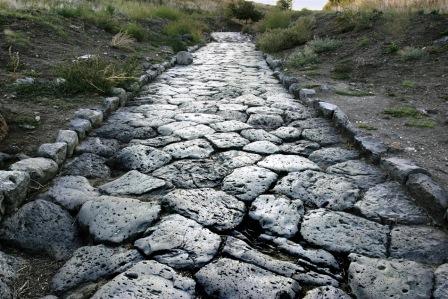
A Roman Road. Built for the military.
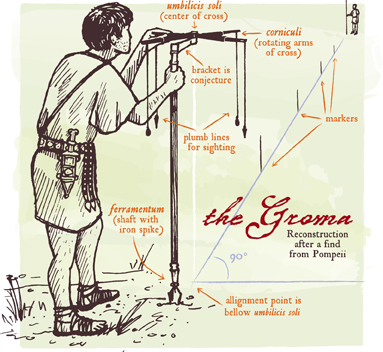
Groma, modern illustration.
YouTube video of a person operating the groma:
http://www.youtube.com/watch?v=rE21igwQYd4)

Diagram of the cross section of a Roman Road.
Source: Pavement Interactive Wiki
In practice, a Roman road rose a bit in the middle to
allow water to drain to the sides.
|
|
|
|
|
|
|
|
|
Aqueducts in the Roman World
To increase the size of a city or
establish new ones, water was critical.
In the ancient Mediterranean world, water was always in short supply.
Wells and nearby rivers simply were not sufficient. Aqueducts were essential,
and many of the 1000 cities of the Empire gained them.
The Romans were proud of their big beauties. Pliny wrote: "The
terrestrial orb offers nothing more marvelous." Remnants of
the aqueducts pop up in the countryside and in cities from
Rome to Spain to Turkey to North Africa.
Aspendos, Turkey. I took these photos in 2014 from the Aspendos
park hillside above the aqueduct. You wander around the Aspendos site, with its forlorn smalli-ish
monuments on the windy hill, until you turn a corner. The aqueduct in
the distance comes marching across the valley to its counterpart.
From your vantage point on the hill, the aqueduct is slightly below,
giving the sensation you can reach out and touch it.
I hadn't previously seen an aqueduct that turned a corner. At this
tower, the turning angle is about 55 degrees.
Additional technical details below:
|
|

The Aspendos aqueduct marching across the valley.
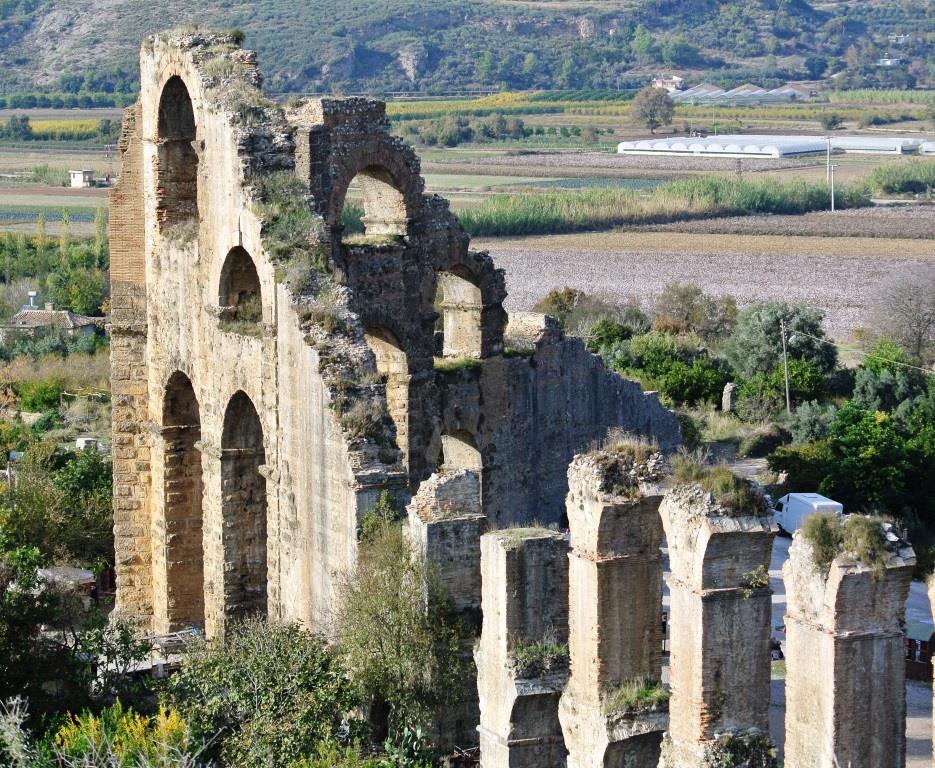
The south end of the
Aspendos aqueduct. The Aspendos aqueduct
is famous for showing the Roman inverted siphon technique.
|
|
|
|
|
|
|
|
|
|
ROME |
|
|
|
List of the Roman Aqueducts for
City of Rome |
|
Date |
Name |
Miles |
Km. |
Notes |
| 312 BC |
Appia |
10 |
16 |
|
| 272 BC |
Anio
Vetus |
40 |
64 |
|
| 144 BC |
Marcia |
56 |
91 |
Longest |
| 125 BC |
Tepula |
11 |
18 |
|
| 33 BC |
Julia |
14 |
22 |
|
| 19 BC |
Virgo |
13 |
21 |
Flowed
continuously for 2000 years |
| 2 BC |
Alsentina |
20 |
33 |
For
Naumachia |
|
AD 38-52 |
Claudia |
42 |
69 |
|
| AD 38-52 |
Anio
Novus |
53 |
92 |
Largest capacity |
| AD 109 |
Trajan |
20 |
35 |
One of
largest. For Baths of Trajan
and Naumachia of Trajan |
| AD 210 |
Antoninina |
n/a |
|
For
Baths of Caracalla |
| AD 226 |
Alexandrina |
14 |
22 |
For
Baths of Nero |
| AD 537 |
|
|
|
Goths cut off aqueducts |
The largest Roman aqueducts
In Rome, there were eleven major aqueducts. The largest were the Anio Novus (though its water was muddy), the Marcia, the Virgo, the Claudia, and later the Trajan.
Length of the Roman aqueducts
The longest of the eleven aqueducts for Rome, the Marcia, covered 56
miles (91.4 km). Altogether, 300 miles (480km) of aqueduct channels were
built to swish water into the city of Rome.
A typical Roman aqueduct was 90% underground. Many of the underground
components have not been located. For example, only recently were the
origins and the probable route of the Aqueduct of Trajan discovered:
www.aqueducthunter.com
Dates
The first of the eleven, the Appia, went up in
312 BC, in the earliest days of Rome. The last
was built 500 years later, the Alexandria in AD 226.
Source of the water
Two aqueducts
originated in the northwest around Lake Bracciano, the Augusta and the
mighty Trajan. Water for the others came from the south and east.
Volume of water
Ridiculous amounts of water flowed into Rome at its height. By the 5th c. AD, the 11 aqueducts in Rome fed over 1300 public fountains with drinking water, 11 imperial baths, over 900 smaller public baths,
and public toilets. Numerous private users were allowed to draw
upon the aqueduct waters.
Water first flowed into reservoirs underground called "castella"
In Rome, this was big business: 247 castella have been documented.
Public toilets were a common use of aqueduct water. Your nose would have told you instantly that Ancient Rome was noticeably sweeter-smelling and more sanitary than other ancient cities.
Though the Romans did not calculate flows, we know the "carrying capacity" of
ten of the aqueducts for the City of Rome was around 300 gallons of water per Roman per day.
In comparison, San Francisco, CA, which today is similar in size, terrain, climate, and source of water,
uses only 83 gallons per resident per day (2009).
The later Roman rulers were Las Vegas-like in their extravagant use of
water in an arid climate. Emperor Augustus built a
dedicated aqueduct, the Alsietina or Augusta. Its sole purpose was to flood an arena (Naumachia) for his mock sea battles.
For the Baths of Caracalla, water came from a
purpose-built aqueduct--the Antonine--into cisterns that could hold over
2 million gallons.
Costs
Roman aqueducts,
like Roman roads, were expensive, perhaps as much as $310,000 per
mile. In modern times, a similar water pipeline constructed in
Australia has cost about 80% less.
End of the Aqueducts
The aqueducts did not collapse all at once when the Roman Empire shifted
from an urban environment to a landed one. One, the Aqua Marcia,
continued to supply Rome with water well into the Middle Ages.
The Goths and other invaders did not destroy them. If invaders cut off
the water supply, the Romans repaired them when the invaders moved on.
The aqueducts declined mostly from lack of demand as cities de-populated
and shrunk. In the hinterlands, a lack of engineering skills among the
few who remained in a city made it too difficult to maintain them.
Elements of a Roman aqueduct system
The aqueduct business was complicated. A
Roman engineer had to:
1. Find the water. Most of Rome's water came from springs in the east in the Sabine Hills, or the southeast in the Alban Hills.
2. Capture the water. The Romans used a catch basin
below the spring or, if the water came from a river, a reservoir and
dam.
3. Protect the water from animals who might want to slurp
it up, from evaporation into the wind, and from water-robbers. Covered
channels were essential.
4. Deliver it to the city. The Romans used
the flow of gravity, unaided by pumping equipment.
5. Capture the water at its destination. At the end of a Roman
aqueduct, castella received and stored the
water.
From a castellum, water flowed to houses, fountains, baths, and workshops through a warren of pipes and underground culverts.
Construction
Gushing, rushing water--poetic but not desirable in a Roman aqueduct. Too
swift and the water would overflow the channel, burst a pipe at its
elbow bend, or scour out the bottom of the channel.
Too slow a flow, and the meandering trickle would pick up unhealthy sludge.
A consistent, gentle slope was the goal of the Roman engineers. The
slope of the Pont du Gard aqueduct in Southern France drops only 2 feet
per mile along its length of 31 miles.
Trenches: Covered trenches followed the natural contours of the ground.
Tunnels: Sometimes a mountain
stood in the way. The Romans built a
tunnel
through it. Roman practice was to build tunnels from both sides of the mountain, with the two meeting in the middle.
Sometimes they missed the mark. The excavators of the Roman Saldae
aqueduct, in North Africa, misaligned their respective diggings, and the
two ends did not meet in the middle of the mountain.
Arcades and walls .
Often there were shallow valleys to cross. Up went a
short, solid wall with the water trench flowing on top of the wall.
In many cases, the Roman engineers built an arcade. An arcade is a bridge with a series of
arches to allow people, or even a raging river, to pass underneath.
The trick was to figure out how high you could build an arched aqueduct before it collapsed. Having developed a good load-bearing arch and keystone, and using cement, the Romans could build an arch
as high as 68 feet.
Stacked Arches: If a higher aqueduct were needed, the Roman engineers simply stacked another set of arches on top of the first set.
Siphon:
The begin point must be higher than the end-point.
The water flowed downward. Once the initial flow reached the bottom of the valley,
the water flowing from behind would force
it back up the hill on the other side of the valley.
For a deep valley, the Romans might use a
water-pressurized, sealed lead pipe, called an inverted siphon.
|
|
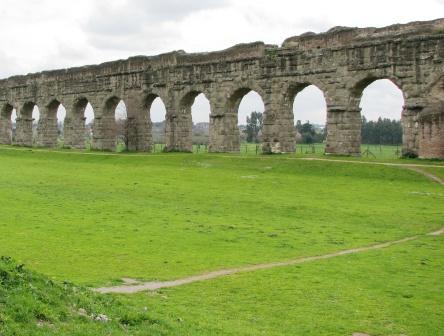
The Roman aqueduct Claudia, outside Rome today.
Courtesy: Wikipedia.
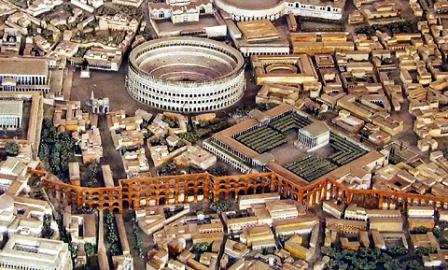
Path of the Roman aqueduct Claudia
inside ancient
Rome (reconstruction).
Courtesy: VRoma
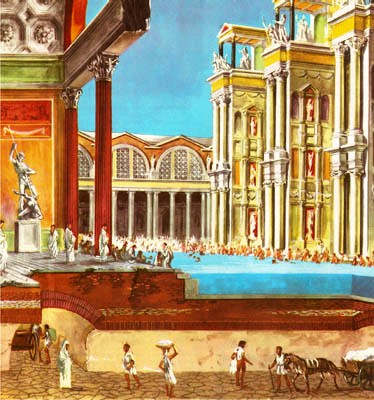
Baths of Caracalla in Rome
(artist's rendition).
Courtesy: David Darling
Built around AD 215, the Baths of Caracalla were a monument to superabundance. They could accommodate
10,000 people. Amenities included a temple, a swimming pool, cold hall,
hot room, exercise courts, and perhaps a library, along with gardens and
statuary.
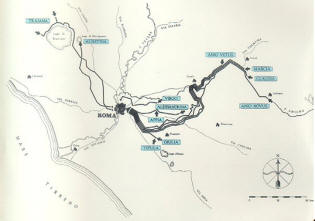
Find the water: Route map of Roman aqueducts.
Courtesy:
Evan Dembskey
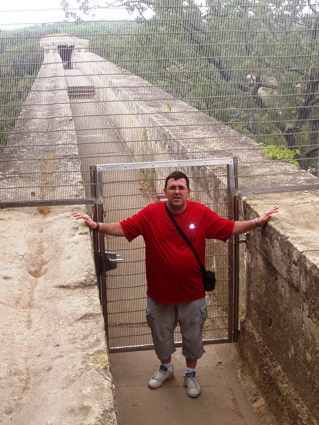
Control the Flow. Uncovered specus of Pont du Gard arched aqueduct. Note relative size of the water channel.
Photo:catedu.es

Aspendos Aqueduct,
Begin Point of the Siphon (North Tower) and Arcade.
Water for the aqueduct originated 12 miles away in the mountains. It was
transported, mostly underground, to the huge north tower in the
distance. Water flowed steadily from the north tower downhill into
a specus (channel on top of the arcade. The arcade was about a
mile long. Two parts are still standing.
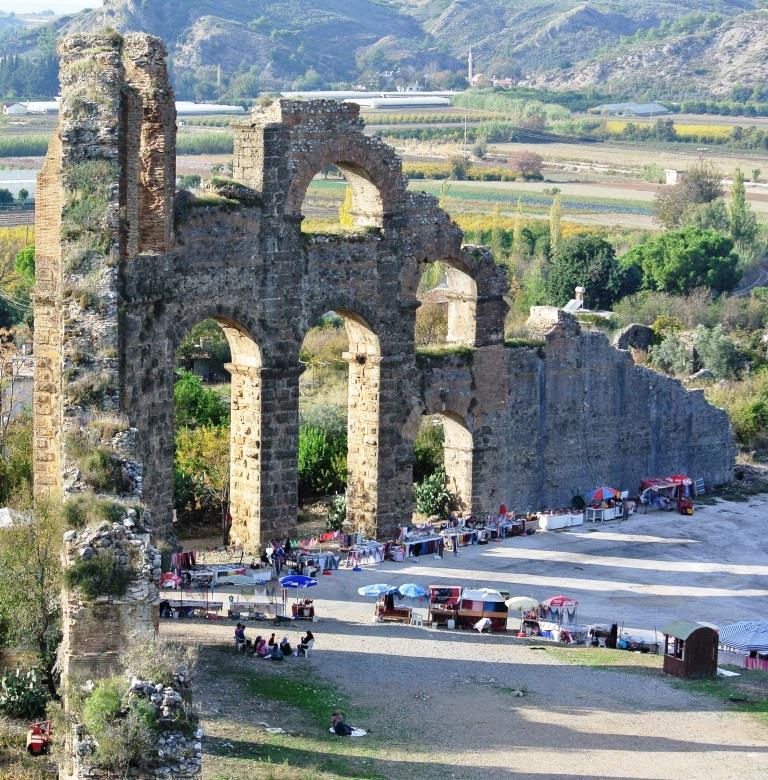
Aspendos Aqueduct End
Point of the Siphon (South
Tower)
Once across the valley, the initial water flowed back up the hill using
only gravity flow. The initial water is forced uphill by the flow of
water falling downward from the North Tower, thus pushing from behind.
The end-point of the siphon, the south tower, had to be shorter
than the north tower, the begin point. The Romans did not have pumps to
pump water uphill, only gravity-flow and the principle of the siphon.
|
|
|
|
|
|
|
|
|
Roman Concrete and Arches
Two major engineering "discoveries" made the roads, aqueducts, and buildings
of the Romans larger than anything else in the ancient world.
Roman cement
and concrete provided a way for roads and sewalls to be
indestructible for 2000 years. Aqueducts could now cross raging rivers.
Roman arches made it possible for buildings, bridges, and aqueducts to
bear enormous weight.
Roman concrete: in
many ancient communities before the Romans, load-bearing walls had to be
pretty low. Often the walls were simply rocks stacked on top of each other.
The older cultures could not solve the problem of joints, the weakest point in construction.
How do you bind adjacent material at the point they join together, so
that the joint doesn't slip and slide and collapse when weight is added,
or when the ground shakes? Before the Romans,
the binders used to hold the joints together were weak.
The first concrete structure: The Romans came up with something different. In the 3rd c. BC,
they discovered "pozzolano," a finely ground silica from
the ash of nearby volcanoes.
Combining this ash with lime and
water, produced an incredibly strong, waterproof, and
fire-resistant binder. Using this new binder plus aggregate, the
earliest concrete structure in Rome was the platform of the
Temple of Concord, built in 121 BC. But Roman concrete--the
cement plus aggregate-- by itself was not enough to keep a
old-fashioned arch from
falling to the ground as weight was added at the top. A new arch
design was needed.
Roman arches: The Romans discovered (or
invented) how to make that arch bear enormous
weight. What they apparently realized was the importance of a the
wedge-shaped stones (the "voussoir") on either side
of the arch. The voussoirs had to be uniform in weight, with the keystone at the top
inserted at a particular angle.
The arch and Roman
expansion: The Roman-style arch was a break-through for Imperial
expansion. Roman towns no longer had to be built on
rivers. Enormous aqueducts could march across the countryside
and across raging rivers, carrying water from far away. Many
more towns could be built, and built inland.
In buildings,
Roman arches enabled temples like the
Pantheon, or the Baths of Caracalla, to soar upwards unencumbered
by supporting columns.
The Pantheon:
The most famous concrete structure in Rome is the Pantheon. Built in the
1st c AD and rebuilt in the 2nd c. AD, the
Pantheon is the oldest roofed building in the world. It is still
intact after 1800 years.
The size of the Pantheon's
dome: The Pantheon's dome is 141 feet high. It has no internal
pillars to support the dome and roof.
With
earlier, weaker
building materials, a pillar-less roof could not have been
built to that height or it would have collapsed.
Roman concrete in the
Pantheon:
At the Pantheon,
Roman cement, mixed with ever lighter
aggregate as the building rose upward, enabled the roof and dome to reach
its lofty height. |
|
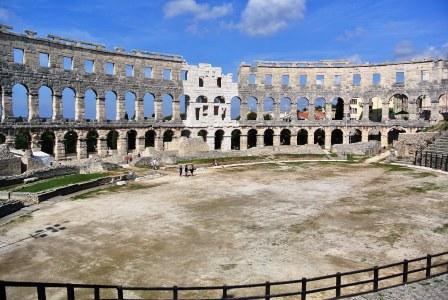
Roman Amphitheater in Pula, Croatia.
In provincial Pula on the Adriatic coast (present-day Croatia,) the Romans built an amphitheater for 23,000. This for a town whose population was perhaps 30,000.
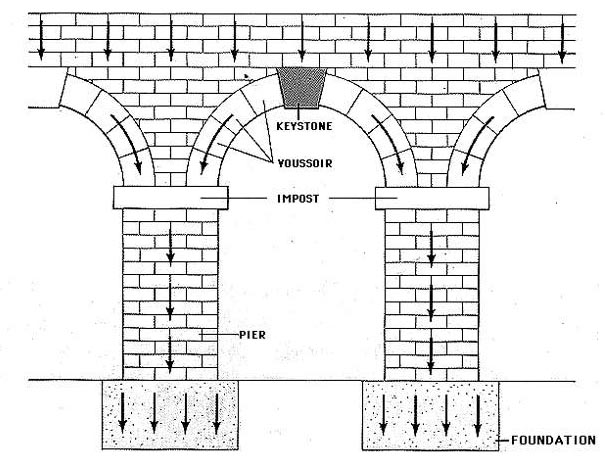
Engineering sketch of a
Roman arch. Note the
voissoirs on each side of the keystone.
Sketch: Sandia
National Labs.

The Roman
Pantheon, interior.
Painting by Panini, 19th c.
The National Gallery, Washington DC.)
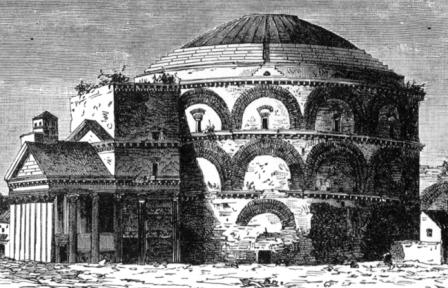
The Pantheon's exterior arches.
From an engraving by E.
Meunier, 19th c.
Source:
www.greatbuildings.com
|
|
|
|
|
|
|
|
|
Sources
Books:
Aicher, Peter, Guide to the Aqueducts of Ancient Rome. Bolchazy-Carducci, 1995
Chanson, Hubert, "The Hydraulics of
Roman Aqueducts," Proceedings of the World Environmental and Water
Resources Congress 2008. Ahupua'a Hawaii.
Dembskey, Evan James, The Aqueducts of Ancient Rome.
M.A. Thesis, U. of South Africa, 2009.
Evans, H, Water Distribution in Ancient Rome: The Evidence of
Frontinus. U of Michigan, 1997.
Internet Resources:
Waters of Rome:
GIS map and timeline
Shows by decade the construction of
aqueducts, water infrastructure, baths, latrines, mills, and
more. Annotated. An excellent source from the University of
Virginia
www.aqueducthunter.com
www.romanaqueducts.info
www.romaq.org
http://orbis.stanford.edu Orbis: the Stanford Geospatial Network Model of the Roman World
http://newscenter.lbl.gov/2014/12/15/roman-architectural-concrete/
The latest on Roman concrete by UCB scientist Marie Jackson. For
advanced technical explanations, go to:
https://berkeley.academia.edu/MarieJackson
|
|
Hodge, A. Trevor,
Roman Aqueducts and Water Supply.
Bristol, 2002.
McClellan, James E., Science and Technology in World History.
Johns Hopkins UP,2006.
Oleson, John Peter, ed.,
Oxford Handbook of Engineering and Technology in the Ancient World,
2009.
Taylor, Rabun,
Public Needs and Private Pleasures: Water Distribution,
the Tiber river, and the Urban Development of Ancient Rome.
Rome, 2000.
White, Kenneth D., Greek and Roman Technology.
Cornell
UP, 1984. |
|
|
|
|
|
|
|
|
|
|
|
|
|
|